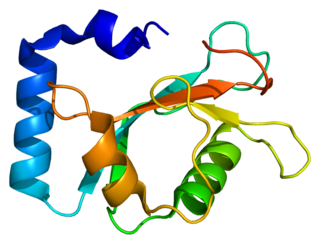Gamma-aminobutyric acid receptor subunit gamma-2 is a protein that in humans is encoded by the GABRG2 gene.
Gamma-aminobutyric acid receptor subunit gamma-2 is a protein that in humans is encoded by the GABRG2 gene.
Gamma-aminobutyric acid (GABA), the major inhibitory neurotransmitter in the brain, mediates neuronal inhibition by binding to GABA receptors. The type A GABA receptors are pentameric chloride channels assembled from among many genetic variants of GABA(A) subunits. This gene encodes the gamma 2 subunit of GABA(A) receptor. Mutations in this gene have been associated with epilepsy and febrile seizures. Alternative splicing of this gene results in transcript variants encoding different isoforms. [5]
GABRG2 has been shown to interact with GABARAP [6] [7] [8] and Dopamine receptor D5. [9]

The GABA receptors are a class of receptors that respond to the neurotransmitter gamma-aminobutyric acid (GABA), the chief inhibitory compound in the mature vertebrate central nervous system. There are two classes of GABA receptors: GABAA and GABAB. GABAA receptors are ligand-gated ion channels ; whereas GABAB receptors are G protein-coupled receptors, also called metabotropic receptors.

The GABAA receptor (GABAAR) is an ionotropic receptor and ligand-gated ion channel. Its endogenous ligand is γ-aminobutyric acid (GABA), the major inhibitory neurotransmitter in the central nervous system. Upon opening, the GABAA receptor is selectively permeable to chloride ions (Cl−) and, to a lesser extent, bicarbonate ions (HCO3−). Depending on the membrane potential and the ionic concentration difference, this can result in ionic fluxes across the pore. For instance, under physiological conditions Cl− will flow inside the cell if the membrane potential is higher than the equilibrium potential (also known as the reversal potential) for chloride ions if the receptor is activated. This causes an inhibitory effect on neurotransmission by diminishing the chance of a successful action potential occurring at the postsynaptic cell. The reversal potential of the GABAA-mediated inhibitory postsynaptic potential (IPSP) in normal solution is −70 mV, contrasting the GABAB IPSP (-100 mV).
The GABAA-rho receptor is a subclass of GABAA receptors composed entirely of rho (ρ) subunits. GABAA receptors including those of the ρ-subclass are ligand-gated ion channels responsible for mediating the effects of gamma-amino butyric acid (GABA), the major inhibitory neurotransmitter in the brain. The GABAA-ρ receptor, like other GABAA receptors, is expressed in many areas of the brain, but in contrast to other GABAA receptors, the GABAA-ρ receptor has especially high expression in the retina.

Gamma-aminobutyric acid B receptor, 1 (GABAB1), is a G-protein coupled receptor subunit encoded by the GABBR1 gene.

Gamma-aminobutyric acid receptor subunit alpha-1 is a protein that in humans is encoded by the GABRA1 gene.

Gamma-aminobutyric acid receptor subunit beta-3 is a protein that in humans is encoded by the GABRB3 gene. It is located within the 15q12 region in the human genome and spans 250kb. This gene includes 10 exons within its coding region. Due to alternative splicing, the gene codes for many protein isoforms, all being subunits in the GABAA receptor, a ligand-gated ion channel. The beta-3 subunit is expressed at different levels within the cerebral cortex, hippocampus, cerebellum, thalamus, olivary body and piriform cortex of the brain at different points of development and maturity. GABRB3 deficiencies are implicated in many human neurodevelopmental disorders and syndromes such as Angelman syndrome, Prader-Willi syndrome, nonsyndromic orofacial clefts, epilepsy and autism. The effects of methaqualone and etomidate are mediated through GABBR3 positive allosteric modulation.

Gamma-aminobutyric acid receptor-associated protein is a protein that in humans is encoded by the GABARAP gene.

Gamma-aminobutyric acid (GABA) B receptor, 2 (GABAB2) is a G-protein coupled receptor subunit encoded by the GABBR2 gene in humans.

The GABAA beta-2 subunit is a protein that in humans is encoded by the GABRB2 gene. It combines with other subunits to form the ionotropic GABAA receptors. GABA system is the major inhibitory system in the brain, and its dominant GABAA receptor subtype is composed of α1, β2, and γ2 subunits with the stoichiometry of 2:2:1, which accounts for 43% of all GABAA receptors. Alternative splicing of the GABRB2 gene leads at least to four isoforms, viz. β2-long (β2L) and β2-short. Alternatively spliced variants displayed similar but non-identical electrophysiological properties. GABRB2 is subjected to positive selection and known to be both an alternative splicing and a recombination hotspot; it is regulated via epigenetic regulation including imprinting and gene and promoter methylation GABRB2 has been associated with a number of neuropsychiatric disorders, and found to display altered expression in cancer.

Gamma-aminobutyric acid receptor subunit beta-1 is a protein that in humans is encoded by the GABRB1 gene.

Gamma-aminobutyric acid receptor subunit rho-1 is a protein that in humans is encoded by the GABRR1 gene.

Gamma-aminobutyric acid receptor subunit alpha-6 is a protein that in humans is encoded by the GABRA6 gene.

Gamma-aminobutyric acid receptor subunit alpha-3 is a protein that in humans is encoded by the GABRA3 gene.

Gamma-aminobutyric acid (GABA) A receptor, alpha 5, also known as GABRA5, is a protein which in humans is encoded by the GABRA5 gene.

Gamma-aminobutyric acid receptor subunit epsilon is a protein that in humans is encoded by the GABRE gene.

Gamma-aminobutyric acid receptor subunit alpha-4 is a protein that in humans is encoded by the GABRA4 gene.

GABAA receptor-γ3, also known as GABRG3, is a protein which in humans is encoded by the GABRG3 gene.

Gamma-aminobutyric acid receptor subunit delta is a protein that in humans is encoded by the GABRD gene. In the mammalian brain, the delta (δ) subunit forms specific GABAA receptor subtypes by co-assembly leading to δ subunit containing GABAA receptors.

Gamma-aminobutyric acid receptor subunit pi is a protein that in humans is encoded by the GABRP gene.

Gamma-aminobutyric acid receptor subunit gamma-1 is a protein that in humans is encoded by the GABRG1 gene. The protein encoded by this gene is a subunit of the GABAA receptor.
This article incorporates text from the United States National Library of Medicine, which is in the public domain.